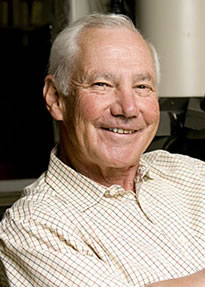Microbial Genomics: Standing on the Shoulders of Giants
Professor Stanley Falkow by Gordon Dougan

Following our opening Standing on the Shoulders of Giants feature on Professor Stanley Falkow, Professor Gordon Dougan from the Wellcome Trust Sanger Institute, UK, discusses the life and research of our first featured Giant.
I first met Stanley during my very first trip abroad to Holland in 1976. At the time I was a PhD student working with David Sherratt on the small plasmid ColE1, which was then being pioneered as a basic replicon for the earliest cloning vectors. It was a time when a handful of DNA restriction enzymes were only available from trusted colleagues, transposons had just been discovered and the use of agarose gels for visualizing plasmids had just been published. At the time, I had read a paper from Stanley on the use of transposons to map plasmids and I was keen to meet him. I attended a seminar he gave at the Free University in Amsterdam and then met him a few days later at a conference in Lunterun, where I presented my own data. By the end of that week my life had been transformed. I had met a scientist who I felt was in a different league and who had a personality to match. Note that at this point he was not world famous. We agreed at the meeting that I would move to his laboratory at The University of Washington in Seattle and I finally arrived there in 1977.
The most remarkable thing about his work was that he had begun to use the very early molecular tools to investigate the mechanisms behind the emergence of multiple antibiotic resistance and was working on exotic pathogens outside of Escherichia coli (E.coli). This was at a time when almost every other laboratory worked on E. coli K12 and basic molecular biology. I was immediately attracted to the practical utility of his approaches and to the fascinating idea that we could actually work out how pathogens caused diseases. I must admit that, at the time, I did not appreciate that his pioneering work would create a whole new field of biology informing the molecular basis of infection. It was tough work applying the then flimsy techniques in fastidious organisms, and there were many times when I thought his efforts would burn out over the next few years. In contrast, he kept driving the field forward, attracting more and more groups into the area and eventually training a unique cohort of scientists known to some as 'Falkow's family'. It became a badge of honour for those inside and sometimes a point of envy for those outside.
He published a series of transformational experiments. To mention a few: the identification of transposases, the cloning and definition of E. coli virulence factors, the generation of genetic systems in Bordetella and other pathogens, the discovery of invasins and the coining of the concept 'Molecular Koch's Postulate'. Too many pioneering steps to mention. He did all of this with a remarkable modesty and a tremendous sense of humour and collegiality. He is a remarkable scientist, but even more a remarkable man.
Looking back, it was a privilege for me to meet and work with a man who invented a new approach to science that has brought so many benefits in fields ranging from diagnostics, through to vaccines and immunology. However, for me the biggest personal satisfaction is seeing the secret world of the pathogenic microbe being revealed step by step, now in such remarkable molecular detail. Remember that I started this small biography describing an era with no sequencing and where, at the start of my PhD, we had not mapped a single gene on ColE1, a tiny plasmid.
Pioneering scientists such as Henry Williams-Smith, Harry Smith and many of the early bacterial geneticists heavily influenced Stanley. However, I say to all working now in the area of host/pathogen interactions, you are all standing on the shoulders of this giant who now spends his time between homes in Palo Alto and Montana, developing eBooks for the teaching he still regularly undertakes at Stanford University, simply because he loves his field.
